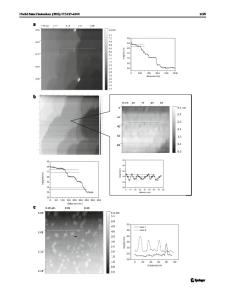Nanoindentation of Epitaxial Films: A Study of Pop-in Events
- PDF / 2,066,088 Bytes
- 6 Pages / 414.72 x 648 pts Page_size
- 102 Downloads / 301 Views
In all cases the pop-ins are of importance as they frequently signify a change in the mode of deformation - prior to pop-in elastic, after pop-in elastic/plastic. It has also been found that the surface chemistry can alter the initial stages of deformation in both ceramics [6] and metals [7]. The pop-ins are completely eliminated for some metals. In this study we have used epitaxial films grown on a GaAs substrate to examine the reproducibility and size of pop-ins in strained films and to assess the effects of atmospheric humidity on the initial stages of deformation in ceramics. The ultimate aim is to identify the causes of the pop-ins and to clarify the effects of surface treatment and preparation. It is anticipated that this will lead to a better understanding of the tribology and wear of materials, and have possible utility for film quality control. EXPERIMENTAL METHODS Sample Preparation All of the samples were grown on GaAs substrates by MBE. A non-epitaxial GaAs substrate was used as a control sample. The different samples tested are detailed in table I. The samples were all kept in the same container and under the same environmental conditions at all times to prevent any one sample being exposed to a humid atmosphere for longer than the others. 271 Mat. Res. Soc. Symp. Proc. Vol. 356 0 1995 Materials Research Society
Table I Test Samples Sample Description GaAs ZnMgSSe:N/GaAs ZnMgSSe:N/GaAs ZnMgSSe:N/GaAs ZnSSe:N/GaAs ZnMgSSe:N/GaAs ZnSe:N/GaAs
Film Thickness N/A Nearly 1 gim Nearly I pim Nearly 1 Itm 0.74 4m 1 jim 1.1 jim
Lattice Mismatch N/A Negligible Negligible Negligible a/a =0.11% aa/a = -0.05% aa/a = 0.25%
Comments Control Sample Medium Mg content High Mg content Low Mg content In compression In tension In compression
Indentation Testing in a Dry Environment The initial indentation testing was performed in a relatively dry environment, at Stanford University, using a Nanoindenter (Nanoinstruments Ltd., Knoxville, Tennessee), the exact
operation of which is detailed elsewhere [8]. All the indentations were performed using the Nanoindenter in constant displacement rate mode whereby the indenter (a diamond Berkovich pyramid) is driven into the specimen at an approximately constant velocity. Each indent consisted of a loading half-cycle followed by an 80% unloading half-cycle, then reloading to maximum, unloading to 80% once more, holding for 120 seconds at constant load and then ending with a final loading cycle before completely unloading. A range of indentation depths were used between 25 nm and 400 nm, though most of the indents were concentrated in the region below 100 nm where the loading curves frequently showed pronounced discontinuities. For each indentation depth a number of indents were performed, typically 10, and the same types of indents were performed on all the samples so that the responses of the different films could be compared. a4 Following the first set of tests, the I,t Berkovich pyramid tip was replaced * Tip 2 with another having a sharper profile. * Tip I The relative shap
Data Loading...










